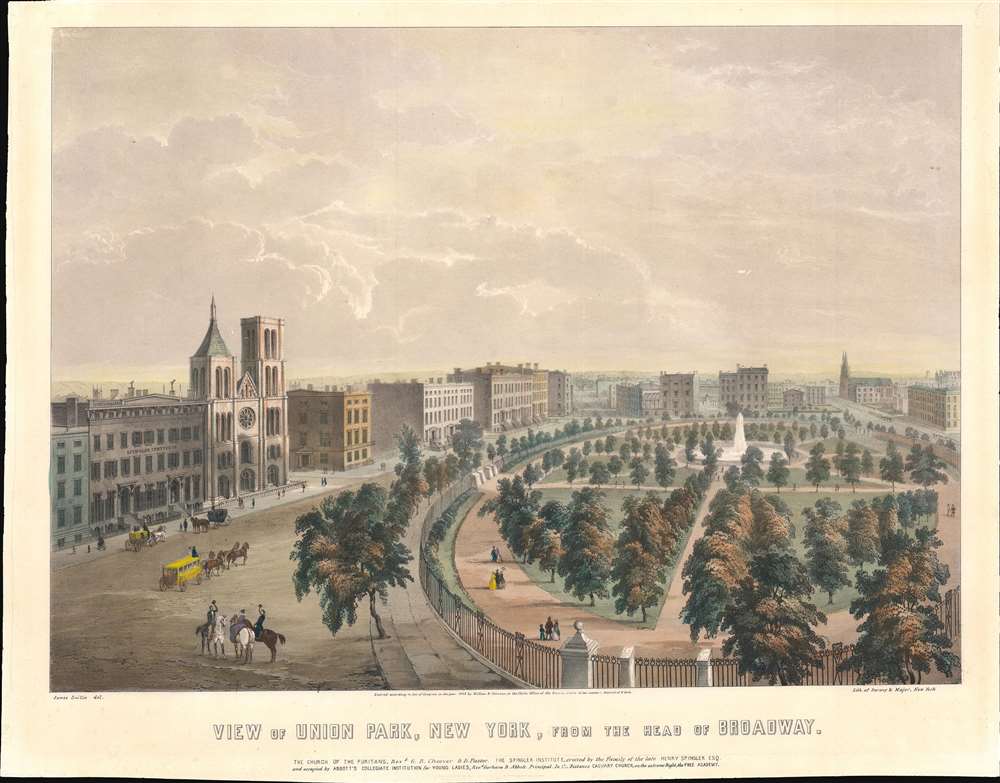This item has been sold, but you can get on the Waitlist to be notified if another example becomes available, or purchase a digital scan.
1849 Smillie View of Union Square and Union Square Park, New York City
UnionPark-smillie-1849
Title
1849 (dated) 14 x 16.5 in (35.56 x 41.91 cm)
Description
Publication History and Census
This view was drawn by James Smillie, lithographed by Sarony and Major, and published by Williams and Stevens in 1849. We note cataloged examples as being part of the collections at the Metropolitan Museum of Art and the Museum of the City of New York.CartographerS
James Smillie (November 23, 1807 - December 4, 1885) was a Scottish American artist and engraver. Born in Edinburgh, Scotland, Smillie first immigrated to Quebec, Canada, with his family in 1821 at the age of 14 and soon joined the family engraving business. He returned to England in 1827 with a desire for further training as an engraver, eventually ending up back in Edinburgh where he studied with Andrew Wilson, purportedly a mediocre engraver, with whom he studied for six months. Smillie visited New York City in 1829 and, finding a demand for his skills as an engraver, moved there in 1830. He had established himself in New York City by 1831 as an engraver of American landscape paintings, as well as engraving banknote vignettes. This reputation led him to work for the American Banknote Company. By 1847, at the age of forty, Smillie was one of the preeminent landscape engravers in the United States. In 1883, at the age of seventy-five, Smillie wrote his autobiography, entitled A Pilgrimage, which recounted his life and more than sixty year career. In 1832, Smillie married Catherine Van Valkenburg, with whom he had two sons, James David and George Henry. Both James and George later became artists. More by this mapmaker...
Napoleon Sarony (March 9, 1821 - November 9, 1896) was a dashingly handsome Canadian-American lithographer and publisher active in New York in the mid to late 19th century. Sarony was born in Quebec and emigrated to New York City in 1835. He apprenticed under Henry Robinson (fl. 1830/33 - 1850) before working as a lithograph artist for Nathaniel Currier (1813 - 1888). In 1846, he partnered with Currier's apprentice lithographer Henry B. Major to establish the firm of 'Sarony and Major.' From offices at 117 Futon Street, they published under this imprint until roughly 1853, when Sarony split off on his own under the imprint 'Sarony and Co.', still at 117 Fulton. At the time 'and Co.' probably meant Joseph Fairchild Knapp (1832 - 1891), Sarony's apprentice, and Richard C. Major, possibly Henry Major's son. In 1857, a new imprint was established as 'Sarony, Major and Knapp'. According to an advertisement in the New York Times (Feb 16, 1864), Sarony had invested in the business at founding, but was not an active partner, possibly because he was traveling in Europe. It is unclear why Sarony's name was maintained, possibly to capitalize on his fame, as a honorific, or possibly because he owned a major stake. They published under this imprint until 1863, becoming a major concern at 449 Broadway. Sarony's name was formally removed from the partnership in 1863. At the time he was traveling in Europe, mastering the most advanced color lithography and photographic techniques. He is known to have worked in France, Germany, and England. He returned to New York in the 1860s, establishing a photography company at 37 Union Square that became famous for its portraits of late-19th-century American theater icons. In 1891, Sarony, hoping to capitalize on Sarah Bernhardt's fame as 'Cleopatra', paid the stage actress 1,500 USD to sit for a photo session, the modern-day equivalent of 20,000 USD - suggesting a highly prosperous business. His son, Otto Sarony (1850–1903), continued the family business as a theater and film star photographer. As an aside, Sarony's second wife, Louie Sarony, was a known eccentric who would reportedly dress in elaborate rented costumes to walk around Washington Square each afternoon. Learn More...
Henry Broughman Major (February 17, 1820 - August 28, 1887) was an American lithographer based in New York in the middle to late 19th century. Major was born in Frome, England and emigrated to the United States in 1834. He apprenticed under Nathaniel Currier (1813 - 1888), befriending Currier lithographer Napoleon Sarony (1821 - 1896). Major worked briefly on his own, or perhaps with his cousin James Parsons Major, from 1845 - 1846 at 10 Watts Street. In 1846 he joined Sarony to found 'Sarony and Major', based at 117 Fulton Street, New York. Henry Major left the firm in 1853 for unknown reasons. At this time, a relative, possibly his son, Richard C. Major, continued to work with Sarony and Joseph Fairchild Knapp (1832 - 1891), creating the firm 'Sarony, Major and Knapp' (1857 - 1863). Learn More...

